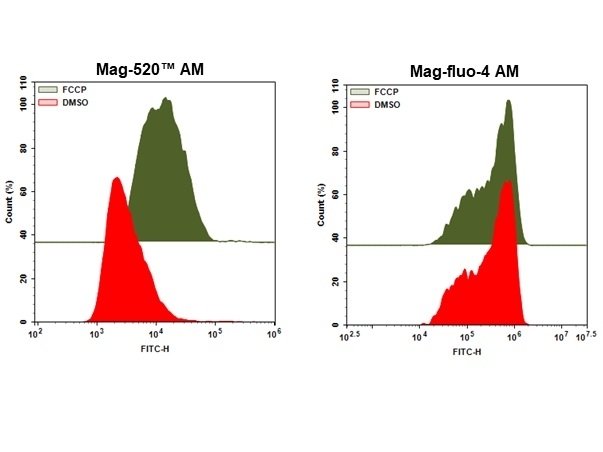Mag-520™ AM
Intracellular magnesium is important for mediating enzymatic reactions, DNA synthesis, hormone secretion, and muscle contraction. A vast majority of the existing magnesium ion indicators are based on tricarboxylate APTRA chelator derived from the popular tetracarboxylate BAPTA calcium ion chelator. They include mag-fura-2, mag-indo-1, mag-fluo-4 and mag-rhod-3. However, all of them have higher affinity for calcium than magnesium although they were designed for detecting magnesium ion. Mag-520™ is the first commercial magnesium indicator that has higher affinity for magnesium than calcium. Its significantly improved selectivity can be used for magnesium signaling applications with fluorescence microscopy or flow cytometry. Mag-520™ AM is cell-permeable with almost identical spectra to those of FITC, making it a convenient fluorescent probe used with FITC filter set that is ubiquitously equipped with almost all fluorescence instruments.


| Catalog | Size | Price | Quantity |
|---|---|---|---|
| 20406 | 10x50 ug | Price |
Physical properties
| Molecular weight | 579.46 |
| Solvent | DMSO |
Spectral properties
| Excitation (nm) | 506 |
| Emission (nm) | 525 |
Storage, safety and handling
| Intended use | Research Use Only (RUO) |
| Storage | Freeze (< -15 °C); Minimize light exposure |
Instrument settings
| Flow cytometer | |
| Excitation | 488 nm laser |
| Emission | 530/30 nm filter |
| Instrument specification(s) | FITC channel |
| Fluorescence microscope | |
| Excitation | FITC filter set |
| Emission | FITC filter set |
| Recommended plate | Black wall/clear bottom |
Contact us
| Telephone | |
| Fax | |
| sales@aatbio.com | |
| International | See distributors |
| Bulk request | Inquire |
| Custom size | Inquire |
| Technical Support | Contact us |
| Request quotation | Request |
| Purchase order | Send to sales@aatbio.com |
| Shipping | Standard overnight for United States, inquire for international |
Page updated on December 26, 2025

